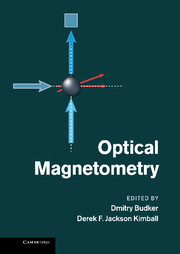Book contents
- Frontmatter
- Contents
- List of contributors
- Preface
- Part I Principles and techniques
- 1 General principles and characteristics of optical magnetometers
- 2 Quantum noise in atomic magnetometers
- 3 Quantum noise, squeezing, and entanglement in radiofrequency optical magnetometers
- 4 Mx and Mz magnetometers
- 5 Spin-exchange-relaxation-free (SERF) magnetometers
- 6 Optical magnetometry with modulated light
- 7 Microfabricated atomic magnetometers
- 8 Optical magnetometry with nitrogen-vacancy centers in diamond
- 9 Magnetometry with cold atoms
- 10 Helium magnetometers
- 11 Surface coatings for atomic magnetometry
- 12 Magnetic shielding
- Part II Applications
- Part III Broader impact
- Index
11 - Surface coatings for atomic magnetometry
from Part I - Principles and techniques
Published online by Cambridge University Press: 05 May 2013
- Frontmatter
- Contents
- List of contributors
- Preface
- Part I Principles and techniques
- 1 General principles and characteristics of optical magnetometers
- 2 Quantum noise in atomic magnetometers
- 3 Quantum noise, squeezing, and entanglement in radiofrequency optical magnetometers
- 4 Mx and Mz magnetometers
- 5 Spin-exchange-relaxation-free (SERF) magnetometers
- 6 Optical magnetometry with modulated light
- 7 Microfabricated atomic magnetometers
- 8 Optical magnetometry with nitrogen-vacancy centers in diamond
- 9 Magnetometry with cold atoms
- 10 Helium magnetometers
- 11 Surface coatings for atomic magnetometry
- 12 Magnetic shielding
- Part II Applications
- Part III Broader impact
- Index
Summary
Introduction and history
Paraffin films and other surface coatings have played a decisive role in the emergence and development of optical magnetometry. When alkali atoms in the vapor phase collide with the bare surface of a glass container, they disappear inside the glass and are replaced in the vapor phase by another atom with random spin orientation. With a mean free path of the dimensions of the cell (typically on the order of 1 to several cm), the collision frequency is much too high, 104 s−1, to maintain the substantial spin polarization required for practical applications. In order to prevent this detrimental effect, vapor cells include either an inert buffer gas [1–3] or an antirelaxation surface coating [4]. In the presence of a noble gas at a pressure from 10−2 to a few atmospheres, the alkali atoms diffuse very slowly from the center of the cell to the glass walls, and their orientation is only very slightly affected by gas collisions. However, there are several advantages to the use of a surface coating instead of buffer gas. If the static magnetic field is not homogeneous, then resonance lines suffer from inhomogeneous broadening in the presence of the gas [5–7]. In addition, the optical pumping process is perturbed by the buffer gas [8, 9]: (i) it is more efficient at the center of the cell than near the uncoated walls, so that the atomic orientation is inhomogeneous inside the cell; (ii) the pump beam absorption line is broadened, and its profile varies with the distance from the entrance window. These effects are unfavorable for the production of alignment in the ground state.
- Type
- Chapter
- Information
- Optical Magnetometry , pp. 205 - 224Publisher: Cambridge University PressPrint publication year: 2013
- 1
- Cited by



